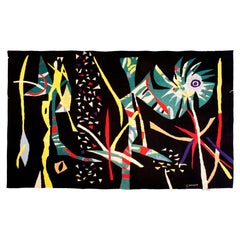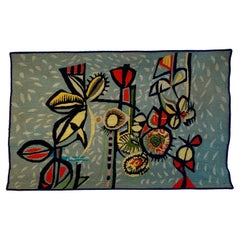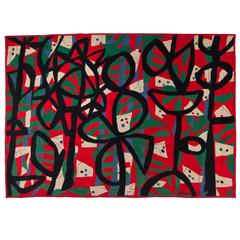Genaro De Carvalho Tapestry
Vintage 1960s Brazilian Space Age Tapestries
Tapestry
Recent Sales
Mid-20th Century Brazilian Mid-Century Modern Tapestries
Wool
Vintage 1960s Brazilian Mid-Century Modern Tapestries
Wool
Vintage 1960s Brazilian Mid-Century Modern Tapestries
Wool
Vintage 1960s Brazilian Mid-Century Modern Tapestries
Wool
Vintage 1960s Brazilian Mid-Century Modern Tapestries
Wool
Vintage 1950s Brazilian Tapestries
Vintage 1960s Brazilian Mid-Century Modern Tapestries
Cotton, Wool
Vintage 1950s Brazilian Mid-Century Modern Tapestries
Cotton, Wool
People Also Browsed
2010s South African Minimalist Night Stands
Wood
Antique Early 1900s Italian Art Nouveau Desks and Writing Tables
Bronze
20th Century French Modern Trunks and Luggage
Brass
Antique Late 19th Century German Table Clocks and Desk Clocks
Bronze
1990s French Modern Trunks and Luggage
Brass
Vintage 1930s French Art Deco Floor Lamps
Alabaster, Chrome
20th Century Japanese Paintings and Screens
Brocade, Silk
Vintage 1920s French Art Deco Doors and Gates
Iron
Vintage 1930s French Art Deco Floor Lamps
Alabaster
2010s Street Art Figurative Prints
Paper, Screen, Watercolor
1980s Pop Art Portrait Drawings and Watercolors
Paper, Crayon, Pastel
1980s Pop Art Portrait Prints
Board, Screen
Antique Early 1900s French Art Nouveau Glass
Art Glass
Antique 1890s French Louis XVI Chandeliers and Pendants
Bronze
Antique Early 1900s French Art Nouveau Glass
Art Glass
Antique 1850s German Art Nouveau Wine Coolers
Metal
On the Origins of Brazilian
More often than not, vintage mid-century Brazilian furniture designs, with their gleaming wood, soft leathers and inviting shapes, share a sensuous, unique quality that distinguishes them from the more rectilinear output of American and Scandinavian makers of the same era.
Commencing in the 1940s and '50s, a group of architects and designers transformed the local cultural landscape in Brazil, merging the modernist vernacular popular in Europe and the United States with the South American country's traditional techniques and indigenous materials.
Key mid-century influencers on Brazilian furniture design include natives Oscar Niemeyer, Sergio Rodrigues and José Zanine Caldas as well as such European immigrants as Joaquim Tenreiro, Jean Gillon and Jorge Zalszupin. These creators frequently collaborated; for instance, Niemeyer, an internationally acclaimed architect, commissioned many of them to furnish his residential and institutional buildings.
The popularity of Brazilian modern furniture has made household names of these designers and other greats. Their particular brand of modernism is characterized by an émigré point of view (some were Lithuanian, German, Polish, Ukrainian, Portuguese, and Italian), a preference for highly figured indigenous Brazilian woods, a reverence for nature as an inspiration and an atelier or small-production mentality.
Hallmarks of Brazilian mid-century design include smooth, sculptural forms and the use of native woods like rosewood, jacaranda and pequi. The work of designers today exhibits many of the same qualities, though with a marked interest in exploring new materials (witness the Campana Brothers' stuffed-animal chairs) and an emphasis on looking inward rather than to other countries for inspiration.
Find a collection of vintage Brazilian furniture on 1stDibs that includes chairs, sofas, tables and more.
Finding the Right Tapestry for You
Whether you hang them behind your bed as a dazzling alternative to a headboard or over the sofa as a large-scale focal point in the living room, vintage tapestries can introduce an array of textures and colors to any space in your home.
Woven wall hangings haven’t consistently enjoyed the popularity or earned the highbrow status that other types of wall decorations have over the years, at least not since the 1970s, which was somewhat of a heyday for tapestries. Today, however, these tactile works of art are seeing a renaissance, as modern weavers are forging new paths in the medium while the demand for antique and vintage tapestries continues to grow.
“We are drawn to texture in environments, and we see tapestries as a subtle layer of soft ornament,” says Lauren Larson of the New York design duo Material Lust. Indeed, and a lot of opportunity comes along when decorating with this distinctive brand of soft ornament.
Think of wall hangings as paintings created by hand with fabric instead of oil or watercolors. If you’re not simply securing your treasure to a wall with nails, pushpins or Velcro, tapestries can be stretched over a frame, used to create a canopy in a cozy living-room corner, hung from a rod or placed inside a shadowbox. And because this kind of textile art is hundreds of years old, options abound with respect to subjects and designs.
For richly detailed depictions of landscapes and garden scenes, look to antique Chinese tapestries and Japanese tapestries. Aubusson tapestries are ornate wall hangings manufactured in central France that are also characterized by romantic portrayals of nature. For weavers of mid-century modern tapestries, as well as those working in textile arts today, the styles and subject matter are too numerous to mention, with artists exploring experimental shapes, bold colors and provocative abstract designs.
Antique, new and vintage tapestries can make a room feel warm and welcoming — find yours on 1stDibs now.


